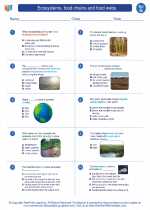Temperate Forest Ecosystem
A temperate forest is a biome characterized by moderate temperatures and a distinct four-season climate. These forests are found in regions with warm summers and cold winters, and they are home to a diverse range of plant and animal species.
Climate
Temperate forests have a moderate climate with four distinct seasons: spring, summer, fall, and winter. The average annual temperature ranges from 10°C to 20°C. The precipitation in temperate forests is distributed evenly throughout the year, with an average of 30 to 60 inches of rainfall annually.
Flora
The vegetation in temperate forests includes a mix of deciduous and evergreen trees, such as oak, maple, beech, and pine. The forest floor is often covered with a variety of shrubs, ferns, and mosses. The diverse plant life supports a wide range of herbivores and omnivores.
Fauna
Temperate forests are home to a variety of animal species, including mammals like deer, bears, squirrels, and foxes. Birds such as owls, woodpeckers, and songbirds are also abundant in these forests. In addition, various reptiles, amphibians, and insects contribute to the biodiversity of the ecosystem.
Soil
The soil in temperate forests is rich in nutrients, which supports the growth of a wide array of plant species. The leaf litter and organic matter that accumulates on the forest floor contribute to the fertility of the soil, creating a favorable environment for plant growth.
Study Guide: Temperate Forest
- What are the characteristics of the climate in a temperate forest?
- Describe the types of vegetation found in a temperate forest.
- Identify three animal species that inhabit temperate forests and explain how they are adapted to this ecosystem.
- Explain the role of soil in supporting the biodiversity of a temperate forest.
- Discuss the impact of human activity on temperate forest ecosystems and potential conservation efforts.
Use the information provided to answer the study guide questions and further explore the fascinating world of temperate forests!
.◂Science Worksheets and Study Guides Seventh Grade. Ecosystems, food chains and food webs

 Activity Lesson
Activity Lesson
 Worksheet/Answer key
Worksheet/Answer key
 Worksheet/Answer key
Worksheet/Answer key
 Worksheet/Answer key
Worksheet/Answer key
 Vocabulary/Answer key
Vocabulary/Answer key
 Vocabulary/Answer key
Vocabulary/Answer key
 Vocabulary/Answer key
Vocabulary/Answer key
 Vocabulary/Answer key
Vocabulary/Answer key
 Vocabulary/Answer key
Vocabulary/Answer key
